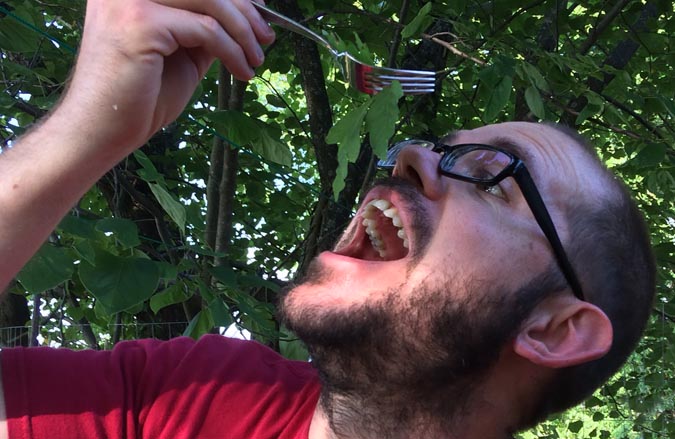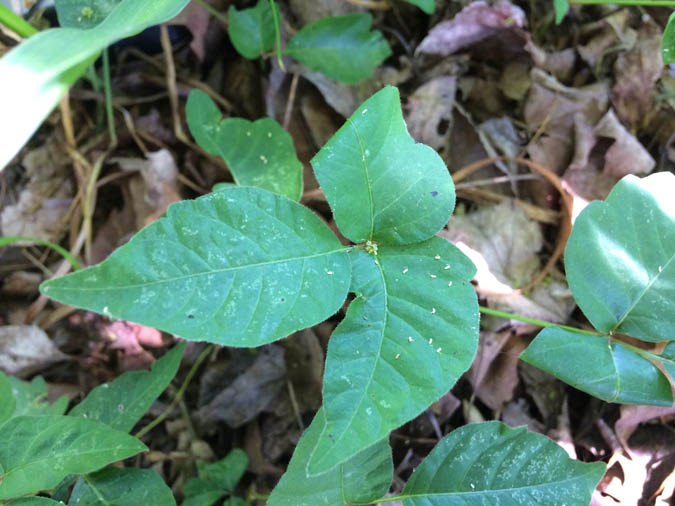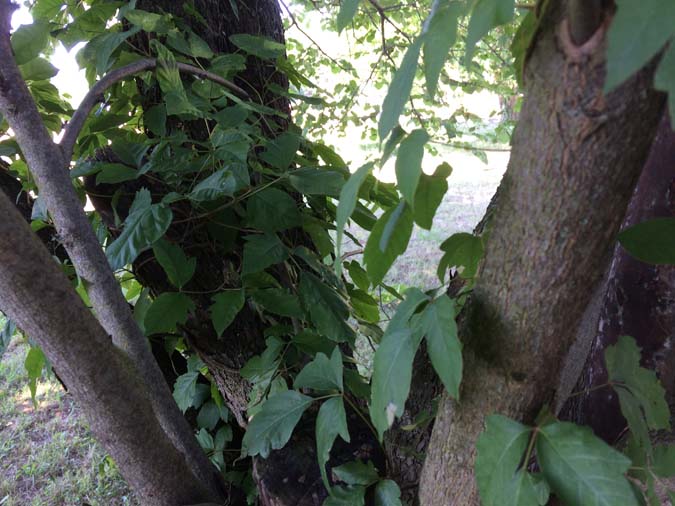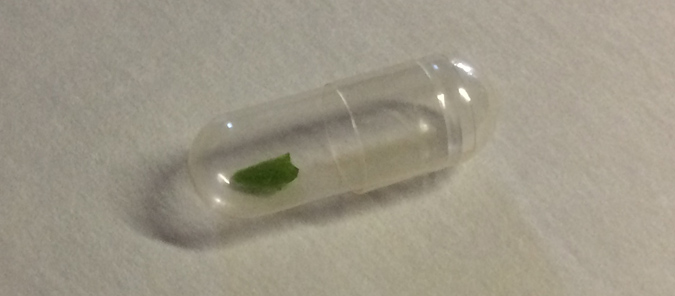“Leaflets of three, let it be.” That’s the familiar rhyme. But could we add a line?
“Eat a leaf to get relief?”
Maybe.
There’s certainly an amount of risk involved, but those who eat poison ivy leaves claim to gain immunity to the plant. I’ll show you how to do it and help you weigh out all the pros and cons.
But remember, this is a controversial topic. I can’t make guarantees about the outcome, and you are responsible for your own actions.
Good?
Okay. Let’s proceed.
Characteristics of Poison Ivy
Poison ivy is not technically an ivy. Rather, it’s a member of the cashew family.
Identification
It grows as a vine or erect shrub. The stems develop aerial rootlets along the sides. The leaflets are always in threes, with the center leaflets having a longer stalk than the side two. Other than this, the leaves are highly variable and can be toothed, toothless, variably lobed, hairless, slightly hairy, glossy, or dull.
Poison ivy also produces white berries in drooping clusters. That’s a good warning sign, by the way. You should almost always avoid plants with white berries.
Read More: “How to Not Die While Wildcrafting”
Where to Find It
Poison ivy and its close relative, poison oak, are native to North America. They can be found in woods and thickets in Mexico, most of Canada, and every state in the U.S. except Alaska. Poison ivy has also found its way to many countries around the world.
This migration is partly due to the efforts of well-meaning herbalists. That’s right. Poison ivy has a history as a medicinal plant. It has been used as a treatment for rheumatism, paralysis, herpes, liver disorders, warts, and (ironically) poison ivy rash.1)Chevallier, Andrew. Encyclopedia of Herbal Medicine. London: DK/Penguin Random House, 2016.2)Elpel, Thomas J. Botany in a Day: Thomas J. Elpels Herbal Field Guide to Plant Families. Pony, MT: HOPS Press, 2004.3)Deane. “Poison Ivy Ponderings.” Eat The Weeds and Other Things, Too. September 09, 2017. Accessed June 06, 2018. http://www.eattheweeds.com/poison-ivy-ponderings/.4)Foster, Steven, and James A. Duke. Peterson Field Guide to Medicinal Plants and Herbs of Eastern and Central North America. Boston: Houghton Mifflin Harcourt, 2014. Apparently, it was quite effective in some of these applications. However, the negative side effects and relative danger of the plant has made its use rare to nonexistent in modern-day herbalism.
Why Poison Ivy Can Cause Irritation
The offending chemical in poison ivy (and in other members of the Toxicodendron genus) is an oil called urushiol. Due to some peculiarities of biochemistry, only humans, certain other primates, and guinea pigs are bothered by it.5)Deane. “Poison Ivy Ponderings.” Eat The Weeds and Other Things, Too. September 09, 2017. Accessed June 06, 2018. http://www.eattheweeds.com/poison-ivy-ponderings/. Some humans also seem to have varying levels of resistance.
The quantity of urushiol changes throughout the year, usually becoming stronger with age. It tends to be contained within the leaves, meaning that you could theoretically touch an undamaged plant all you want without getting a reaction. I say “theoretically” because even a tiny puncture of the leaf, such as from an insect bite, can release the oil without you knowing it. But if contact is unavoidable, use a light touch and you might get away unscathed.
What to Do if You’ve Been Exposed
If you do come in contact with the plant, scrub the area with soap and water within a few hours and you may avoid a reaction. The juice of the jewelweed plant is also said to help prevent a reaction and to relieve itching.6)Foster, Steven, and James A. Duke. Peterson Field Guide to Medicinal Plants and Herbs of Eastern and Central North America. Boston: Houghton Mifflin Harcourt, 2014.
The problem is that you don’t always know you’ve been exposed. Urushiol is a surprisingly stubborn chemical. It can be carried by rain water that has fallen on leaves. Pets or wild game can carry the oil on their fur. Even burning the plant doesn’t destroy it. Urushiol is carried in the smoke and can cause a dangerous reaction in those that breath it.7)Foster, Steven, and James A. Duke. Peterson Field Guide to Medicinal Plants and Herbs of Eastern and Central North America. Boston: Houghton Mifflin Harcourt, 2014.8)Elpel, Thomas J. Botany in a Day: Thomas J. Elpels Herbal Field Guide to Plant Families. Pony, MT: HOPS Press, 2004. Even a hundred-year-old dried specimen can cause a reaction.9)Foster, Steven, and James A. Duke. Peterson Field Guide to Medicinal Plants and Herbs of Eastern and Central North America. Boston: Houghton Mifflin Harcourt, 2014.
If you develop a reaction, take heart. This too shall pass. Use cooling herbs, such as cleavers, chickweed, or dandelion, both externally and internally. Clay will also help soothe the area and draw out inflammation. A lukewarm bath with salt and baking soda should also help.
The pain and itch of poison ivy comes from urushiol’s ability to trick your body into attacking affected skin cells. To the body, these affected cells appear to be foreign material.10)Deane. “Poison Ivy Ponderings.” Eat The Weeds and Other Things, Too. September 09, 2017. Accessed June 06, 2018. http://www.eattheweeds.com/poison-ivy-ponderings/. The result is itching, sores, and bleeding.
How to Eat Poison Ivy
As stated above, eating poison ivy is a controversial topic, and I cannot guarantee that you won’t have a reaction. It’s a practice that people really do partake in without suffering ill effects, and I’ll help you minimize the risks.
However, interacting with poison ivy carries more risk than you’re exposed to with most other popular edible and medicinal plants. Anything you do here is at your own peril.
Selection
Use young leaves. Urushiol content typically increases with time. Also, leaves with less of a glossy appearance will likely have a lower concentration of urushiol.11)Elpel, Thomas J. Botany in a Day: Thomas J. Elpels Herbal Field Guide to Plant Families. Pony, MT: HOPS Press, 2004.
Quantity
Start with a tiny piece of leaf. You can use tweezers to pluck off the tip of a leaf. While some people will eat whole leaves, I see no reason to jump in. Why not first see if you’ll have a reaction to a small amount and then, if desired, work your way up.
Ingestion Strategy
Some people will pluck a few leaves each spring and just chew them up right then and there. That’s nice for them, but I’m a bit more cautious. One method of protecting your mouth is to roll the piece of leaf up in a bit of bread. There’s no need to get fancy. We’re not making a poison ivy sandwich. Just roll it into a ball and compress it down into as small a size as possible. Then swallow the whole thing like a pill. If a bread ball is too large to swallow, or if you’re gluten intolerant like me, you can enclose your bit of leaf in a gel capsule instead.
Frequency
I wouldn’t suggest eating more than one piece a day. In fact, you might want to put a couple of days between your first attempt and your second, just to give yourself plenty of time to gauge your reaction. The first time I ate poison ivy, I woke up in the night with difficulty breathing. As it turned out, this was from inhaling mold and dust during a bathroom remodel. But you’d better believe I gave myself the next day off to be absolutely sure of what was going on with my body.
Some people eat poison ivy one time each year and claim to have immunity until the following year. These seem to be the same people who eat one or more whole leaves. It may be that they have built up a high resistance over time and their yearly dose acts like a booster shot.
Other people start with the tip of a leaf and work their way up to a whole leaf, increasing their dose each day over a period of a week or two. This would be akin to how people take allergy shots in increasing doses to build up tolerance over time.
Alternative
You might also try drinking milk from a goat that has been eating poison ivy. This is another classic folk remedy, though its reported effectiveness seems less consistent.12)Foster, Steven, and James A. Duke. Peterson Field Guide to Medicinal Plants and Herbs of Eastern and Central North America. Boston: Houghton Mifflin Harcourt, 2014. Adding another animal into the equation adds a lot of new variables.
Immunity?
Will eating poison ivy really make you immune? This is a tricky topic. First, we’re probably talking about resistance, rather than true immunity. So does eating poison ivy grant resistance?
It depends.
For some people, yes, eating poison ivy does seems to grant a heightened resistance.13)Hoffmann, David. Medical Herbalism: The Science and Practice of Herbal Medicine. Rochester, VT: Healing Arts Press, 2003.14)Elpel, Thomas J. Botany in a Day: Thomas J. Elpels Herbal Field Guide to Plant Families. Pony, MT: HOPS Press, 2004.
Some people like to naysay this idea and relegate it to an old folk story, but in addition to ample anecdotal evidence, the concept has been experimentally verified in guinea pigs.15)”Immunologic Studies of Poisonous Anacardiaceae: Oral Desensitization to Poison Ivy and Oak Urushiols in Guinea Pigs.” Egyptian Journal of Medical Human Genetics. January 05, 2016. Accessed June 06, 2018. https://www.sciencedirect.com/science/article/pii/S0022202X15439259.
Still, an animal study and anecdotal evidence leave us with a lot of questions. Life is complicated, and there are likely a number of unknown variables at play.
So where does this leave us?
Our footing is not as firm as I would like, but I can say that some people really do eat poison ivy. I am now one of those people. And eating poison ivy does seem to have the potential to increase your resistance to the plant. Unfortunately, those who are most in need of poison ivy resistance are the same ones who should be most careful when eating it. A reaction could potentially cause severe effects, including airway constriction and asphyxiation.16)Elpel, Thomas J. Botany in a Day: Thomas J. Elpels Herbal Field Guide to Plant Families. Pony, MT: HOPS Press, 2004.17)Foster, Steven, and James A. Duke. Peterson Field Guide to Medicinal Plants and Herbs of Eastern and Central North America. Boston: Houghton Mifflin Harcourt, 2014. So again, eating poison ivy is a treatment possibility that should be used with extreme caution.
So what do you think? Is it too risky, or is it a plausible therapy? Have you eaten poison ivy before? Do you know anyone who has? Are you thinking about trying it? Have you got any poison ivy remedies or treatments I didn’t mention? Did you feel itchy while reading this? Let me know in the comments.
Psst! Our Lawyer Wants You to Read This Big, Bad Medical Disclaimer –> The contents of this article, made available via The Grow Network (TGN), are for informational purposes only and do not constitute medical advice; the content is not intended to be a substitute for professional medical advice, diagnosis, or treatment. Always seek the advice of a qualified health care provider with any questions you may have regarding a medical condition. If you think you may be suffering from any medical condition, you should seek immediate medical attention. You should never delay seeking medical advice, disregard medical advice, or discontinue medical treatment because of information provided by TGN. Reliance on any information provided by this article is solely at your own risk.

Scott Sexton is a TGN Trailblazer, a highly experimental gardener, an unrelenting weed-eater, and a largely non-profit herbalist (much to his wife’s chagrin). When Scott is not teaching foraging classes, testing out theories in the garden, or grazing in the forest, he can be found at his Facebook page, “A Forager’s Guide to the Zombie Apocalypse.”
References
| ↑1 | Chevallier, Andrew. Encyclopedia of Herbal Medicine. London: DK/Penguin Random House, 2016. |
|---|---|
| ↑2, ↑8, ↑11, ↑14, ↑16 | Elpel, Thomas J. Botany in a Day: Thomas J. Elpels Herbal Field Guide to Plant Families. Pony, MT: HOPS Press, 2004. |
| ↑3, ↑5, ↑10 | Deane. “Poison Ivy Ponderings.” Eat The Weeds and Other Things, Too. September 09, 2017. Accessed June 06, 2018. http://www.eattheweeds.com/poison-ivy-ponderings/. |
| ↑4, ↑6, ↑7, ↑9, ↑12, ↑17 | Foster, Steven, and James A. Duke. Peterson Field Guide to Medicinal Plants and Herbs of Eastern and Central North America. Boston: Houghton Mifflin Harcourt, 2014. |
| ↑13 | Hoffmann, David. Medical Herbalism: The Science and Practice of Herbal Medicine. Rochester, VT: Healing Arts Press, 2003. |
| ↑15 | ”Immunologic Studies of Poisonous Anacardiaceae: Oral Desensitization to Poison Ivy and Oak Urushiols in Guinea Pigs.” Egyptian Journal of Medical Human Genetics. January 05, 2016. Accessed June 06, 2018. https://www.sciencedirect.com/science/article/pii/S0022202X15439259. |












COMMENTS(6)
Those of you familiar with Homeopathy know that there is a remedy made from poison ivy or poison sumac called Rhus Toxicodendron (Rhus Tox) and is sold in most health food stores or online where ever remedies are sold. ( usually for less than $8.00) Homeopathy is the concept of ‘like cures like’. For this reason, Rhus tox is widely used for joint stiffness and sore joints that are better with movement. (Meaning stiff when you first get up and better as you walk it out.)
If you’d like to use this remedy for sensitivity to poison ivy, oak or sumac you can take it prophylactically. You can start taking a dose once per week for a month before the growing season begins. This can be continued throughout the season.
Homeopathy is symptom-driven so Rhus tox will help once you are experiencing symptoms if there is relief from a hot shower and if vesicles are located around the face, eyes, palms and/or genitals.
My favorite remedy for poison ivy, oak or sumac, however, is Anacardium orientale for swelling and itching with intense burning. Scratching makes it worse, but rubbing feels better. It is usually worse at night, especially from warmth of the bed.
Graphites is the remedy of choice if when scratched there is a honey-colored oozing that is sticky and burns.
Croton tiglium is the remedy of choice when there is a rash with blisters that itch. Scratching aggravates and the rash is usually left-sided with yellow oozing that scabs.
Sulphur is the remedy of choice when scratching brings on bleeding. The bleeding aspect usually makes it feel better. The person may feel better in a warm bed, does not want to bathe and can be irritable and restless.
30c is a good basic potency to buy and easy to source. It is also what is usually in homeopathic kits. Dose 3-4 times daily until improvement, then less often. If not enough relief, move on to the next closest indicated remedy.
As soon as my book “Mastering Alternative Medicine, Your Family’s Guide to Well” (First-Aid & Common Conditions) is published I will let Marjory know so she can bring you a special offer.
I second this recommendation. I know that the “scientific” community pooh, poohs Homeopathy and says it’s “just a placebo effect”. But you can’t cause a sick 2 year old’s nose to run within 15 SECONDS of taking a name brand homeopathic remedy (purchased from a local store) for a cough and stuffy nose. He had an earache and it was gone within 30 minutes. He awakened in the night, I gave him a second does (as prescribed for his age and weight) and he fell back asleep. Saved him another round of antibiotics. And a year and an half later, the earaches haven’t returned.
I say use whatever works. Whether it’s herbs, homeopathy, massage, energy healing, taking a nap, or even conventional pharmaceuticals. If it’s really helping you enter into a more healthy state of being, then do it. 🙂
I agree that homeopathy would be a great way to go. And as a side note, I think we’ve glossed over the placebo effect too quickly. Rather than dismissing something as a placebo effect, I think we should be pausing longer to consider why we have any placebo effect at all. To me, the implications of the phenomenon seems more significant than we give it credit for.
as a child i had horrendous poison ivy outbreaks. it would travel all over my body for weeks making me miserable and after some years i would get sick, fever nauseau etc. The Dr’s gave me shots of who knows what back in the 50’s i got it falling into water standing in the smoke of some that burned on a tree really bad. so… i’m out in brushy area and nature called… guess what! yup i used the WRONG plant to wipe with. i had recently heard of drinking a tea made with the leaves… or eating some. I figured it prolly couldn’t get worse so i grabbed 4 leaves and chomp it up! I have not had much reaction since 50+ years. a cppl times one or two bumps, but i pull it up out of my garden and yard almost daily now and knock wood, it’s all good.
I have had two bouts with poison ivy this summer. The first time a couple of old timers told me it was red bugs biting me (aka Chiggers). So I scratched and it got worse, then I took Rhus Tox for 2 weeks, it didn’t help me. I had dealt with the rash for 7 weeks. I used black soap, which helped to draw and dry out some of the rash, but didn’t help to contain it, probably because it really itched, and that spread it. Finally the rash went away. This time I wasn’t going to fool around with this awful rash, so I ordered the anacardium orientale 200C from their web site, I couldnt find it at any of the whole food stores, I believe it actually started to heal the rash immediately. I have been taking the anacardium for 5 days, the poison ivy rash is gone! I don’t think I want to eat the leaves of the plant, so I will keep the anacardium orientale in my medicine chest!